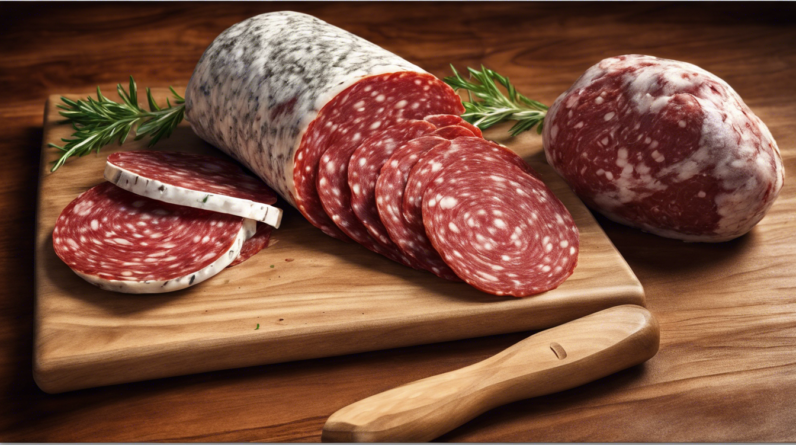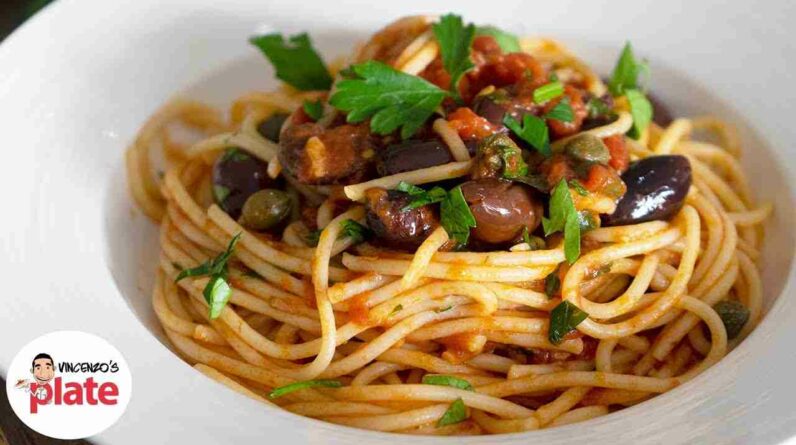Ah, the storied Sunday gravy! This is not just a meal; it’s a symphony of flavors that has been serenading Italian-American tables for generations. Picture this: It’s Sunday morning, the scent of simmering tomatoes and garlic wafts through the air, the sound of bubbling pots sets the rhythm, and anticipation builds for the feast that lies ahead. This iconic sauce, known in Italy as sugo, has roots as deep and intertwined as those of an ancient olive tree in the sun-drenched soils of the Mediterranean.
The tale of the Sunday gravy begins with Italian immigrants who journeyed to America at the turn of the 20th century. Bringing along their culinary traditions, they sought to recreate the flavors of home using the ingredients they found in their new land. The more modest sugo of Italy, often a simple concoction of tomatoes, garlic, and herbs, was transformed in America. With the abundance of meat available, families began to add pork, beef, and sausages, elevating the sauce to a hearty centerpiece of the Sunday meal, when extended family would gather to relax and connect.
Furthermore, this tradition is a testament to the importance Italians place on food as a binding force. In Italian culture, a meal is not just sustenance but a reason to come together, engage in lively conversation, and reinforce familial bonds. And what could represent this philosophy better than a pot of Sunday gravy, simmering for hours, the center of attention, coaxing everyone to the table?
The evolution of Sunday gravy is also a story of adaptation. In the heat of the Italian-American kitchens, a unique culinary identity was forged—one that honored the past but embraced the new and abundant. In that sense, Sunday gravy not just nourished the body but also warmed the soul, securing its place as a delicious relic of cultural fusion. It bridged the old world with the new, one ladleful at a time.
Today, whether it’s called gravy or sauce is a topic of friendly debate in Italian-American communities, but what remains undisputed is its significance. To stir a pot of Sunday gravy is to engage with history, to be a part of a lineage of home cooks who have long understood that food made with love is the true essence of hospitality.
Now, let’s roll up our sleeves and prepare to give tribute to this time-honored tradition as we gather the freshest ingredients and embark on the culinary journey of creating your very own pot of Sunday gravy. The secret lies in the quality of the ingredients, the patience in the cooking, and most importantly, the joy in sharing it with loved ones. So, tie on your apron, and let’s get ready to dive into the heart of Italian-American cooking!
Ingredients you’ll need for an authentic sugo
Gearing up to make a genuine pot of Sunday gravy is akin to preparing for a grand orchestra performance—the ingredients, each unique in flavor, need to harmonize perfectly for the masterpiece to come to life. You’ll be taking a page from nonna’s secret book, where the magic starts with quality components that come together to create something transcendental, something that feels like a warm hug from the kitchen.
Remember, folks, it’s not just about tossing in what you’ve got in the pantry—selecting the right ingredients is crucial to capturing the soul of this dish. Now, let’s march through the marketplace as we gather our medley of fresh, robust flavors.
First and foremost, the tomatoes. Whether you’re going for peeled San Marzano or plum tomatoes, they are the cornerstone of a good sugo. Make sure they’re ripe and bursting with that sweet, acidic goodness that only the best tomatoes can deliver.
- Tomatoes: Whole peeled San Marzano or other high-quality plum tomatoes.
- Meat: Braciole (rolled and stuffed beef), Italian sausage, meatballs, and perhaps a piece of pork or veal for good measure—the more variety, the richer the sauce.
- Olive Oil: Extra virgin, of course, for the sautéing.
- Garlic: Sliced or finely chopped. Don’t be shy, garlic is a sweetheart in this recipe.
- Onion: Often the unsung hero, finely diced for that hidden depth of flavor.
- Herbs: A fragrant combination of basil and oregano, fresh if possible, or dried if it’s what you’ve got on hand.
- Salt & Pepper: These two go without saying, to season every layer as we go.
- Wine: A splash of red—a good one that you wouldn’t mind sipping while you stir the pot.
- Cheese: Grated Pecorino Romano or Parmigiano-Reggiano, because what’s a Sunday gravy without cheese to sprinkle on top?
It’s not just about throwing these into a pot. It’s about understanding their role in the ensemble—how the aromatics build the base, how the tomatoes provide the melody, and how the symphony of meats adds depth and complexity. Each ingredient is a soloist, ready for their moment in the spotlight.
And let’s not forget a topic that often sparks some fiery debate—the use of a sweetener is a personal choice. Some cooks swear by a pinch of sugar to counter the tomatoes’ acidity; others let the natural sweetness of the ingredients do the talking.
There you have it, a shopping list that reads like an invitation to create something truly exquisite. Now that your kitchen counter is brimming with the perfect cast of ingredients, you’re ready to make Sunday gravy that’ll be the talk of the table, and perhaps the neighborhood. So cinch your apron, wield your best wooden spoon, and let’s set the stage for a little Italian culinary alchemy!
Step-by-step guide to making Sunday gravy

With your pantry and fridge bearing the finest ingredients, you’re ready to embark on the culinary adventure of making authentic Sunday gravy. Let’s take tradition and turn it into something tangible, something delectably your own to share with friends and family.
The first steps are akin to starting a great piece of music; it’s about layering the elements together. Take out your largest pot, one that seems to whisper tales of the countless family gatherings it has seen, and set it over a medium flame.
Add that extra virgin olive oil until it shimmers like a still lake at sunrise. Now it’s time for the garlic and onion to take the stage. Once your garlic begins to sing and your onions dance translucent, the foundation of our gravy melody begins.
Next come the meats. Whether it’s the braciole, tender and filled with herby breadcrumbs, or the Italian sausages that snap with every cut, each piece needs to be browned to perfection. This isn’t mere cooking; it is an act of love, imbuing the sauce with soul-satisfying richness. Remember, we’re not just browning; we’re coaxing out flavors that will hug every strand of pasta like a long-lost friend.
Once the meats are seared and set aside, we give the stage back to the tomatoes. Those San Marzano beauties deserve to be crushed by hand, a process that feels as rustic as it does therapeutic. Pour them into the pot with those aromatic juices and let them stew, joining the harmonious backdrop that your sautéed garlic and onion have created.
Now comes the transformative part: reintroduce the meats to the pot. They’ll bask in the tomato bath, slow dancing over the next few hours until every morsel is tender enough to melt in your mouth.
It’s crucial now to season thoughtfully with salt and pepper, then add the basil and oregano—a fragrant nod to the lush Italian countryside. If your choice of melody includes a splash of red wine, let it join the symphony now, elevating the sauce to a level of complexity that whispers tales of the old country.
Then comes the waiting, the slow simmer that builds anticipation. Keep the heat low and gentle; patience is the secret ingredient here. Your kitchen fills with the aroma of simmering gravy—a scent that tells stories of Sundays past and whispers promises of the feast to come.
Stir occasionally with a wooden spoon, the same way generations have done before. This isn’t just cooking; it’s a ritual, a time to reflect, to laugh, and to share the first tastes with those meandering into the kitchen, drawn by the irresistible aroma.
After a few hours, when the sauce has thickened to a velvety texture and the meats are tender to the fork, it’s time. A sprinkle of cheese, a final stir, and your Sunday gravy is ready to grace the table and unite loved ones.
What you’ve created isn’t just a dish; it’s a masterpiece, a convergence of history, culture, and the love that’s shared when families come together. Your Sunday gravy is more than ready; it’s a testament to the beauty of Italian-American tradition in every spoonful.
Tips for achieving the perfect flavor and consistency
Making Sunday gravy is like conducting a culinary orchestra, where the balance of flavors is paramount. Every note must come through, harmonizing into a mouthwatering crescendo that makes Sunday the most anticipated day of the week. Here are some insider tips to ensure your gravy hits all the right notes, time and time again.
First, the simmer. Perfection in your pot emerges from hours of low and slow cooking. It’s tempting to rush this step, but resist the urge! The gentle bubbling is where the magic happens, infusing every element with rich, deep flavors. The art of patience shines here—let the heat do its work, melding the meats and tomatoes together.
Next, it’s all about layering those flavors. Begin by seasoning your meats generously before browning them. This not only enhances the taste of the meats themselves but also contributes to the foundational flavor profile of the sauce. As you brown your meats, fond forms at the bottom of the pan — these browned bits are flavor goldmines! Deglaze your pot with a bit of wine, scraping those bits up to fold incredible flavor back into your gravy.
Speaking of wine, choose one that matches the robustness of your sauce. A nice, full-bodied red will complement the rich flavors of the meat and tomatoes. Add the wine early enough so that it has time to cook off the alcohol, leaving behind only its delicious essence.
Now, let’s talk consistency. If your gravy seems too thin, let it simmer uncovered to reduce and concentrate the flavor. For those who like it even thicker, some nonnas swear by a little trick—mash a few of the cooked tomatoes against the side of the pot and stir them back in. You get all natural thickness without affecting the authenticity of your gravy.
The choice of sweetener, as indicated before, remains a personal touch. But should you choose to add sugar or another sweetener, do so sparingly and taste as you go. The inherent sweetness from the tomatoes and onions, along with the savory elements, usually strikes that desired balance.
Finally, keep in mind that a good Sunday gravy is as much about texture as it is about taste. Meats should be succulent and fall-apart tender, melding with the sauce rather than standing apart from it. Achieve this by ensuring you don’t boil the sauce. A gentle simmer invites tenderness; a rolling boil can toughen your meats.
By following these tips, your Sunday gravy will not just provide a flavor experience but will also tell a story—the story of time-honored Italian tradition passed down through generations, adjusted by hands that have mastered the craft. It’s a labor of love, a show of culinary prowess, with the power to transport you to a family table brimming with laughter and the heartwarming aroma of a well-prepared sugo.
Serving suggestions and traditional pairings

Now, after hours of preparation and simmering patience, the moment of truth has arrived – it’s time to serve your masterpiece. Italian Sunday dinners are an event that transcends the mere act of eating. They’re a weekly communal rite that fuses love, laughter, family, and of course, food. The centerpiece is your pot of Sunday gravy, and how you serve it can elevate this tradition even further.
The classic way to honor this sauce is to marry it with the perfect pasta. A hearty, robust pasta like rigatoni or penne is ideal – their ridges and tubes eagerly embrace the thick gravy, ensuring each bite is harmoniously coated. Cook your pasta al dente, just firm enough to keep its integrity against the weighty sauce.
When it’s time, lay your pasta as a generous foundation on each plate. With a sacred heaping ladle, crown the steaming pasta with your Sunday gravy, ensuring each plate gets its fair share of meat. The sight of the succulent braciole, meatballs, and sausages nestled atop the pasta is enough to draw a chorus of appreciative sighs from around the table. It’s a ritual, and with every serving, the ties that bind us to our traditions are reinforced.
A sprinkle of grated Pecorino Romano or Parmigiano-Reggiano is non-negotiable. It gently melts into the warm folds creating a perfect union of flavors. But take it even further by offering additional cheese at the table – it’s a hospitable touch that lets your loved ones fine-tune their plate to perfection.
Don’t let the meats play second fiddle; they’re stars in their own right. Serve them separately on a platter adorned with fresh basil leaves. Each diner can select their preferred cuts, turning their plate into a personalized feast where every bite tells a part of the story you’ve simmered into that sauce.
But what of the bread? Ah, yes, the bread. No Sunday gravy experience is complete without it. A basket of crusty Italian bread should sit ready to sop up any sauce that dares to remain. It’s the ultimate comfort food gesture – a cleanup that’s as delicious as the meal itself.
And while the culinary spotlight shines on the sauce and pasta, remember the accompaniments—perhaps a crisp salad dressed with olive oil and vinegar to cut through the richness, or some char-grilled vegetables seasoned with sea salt and herbs, offering a fresh contrast to the indulgent main course.
As for beverage pairings, a bottle of robust Italian red wine is your best friend. Think Chianti, Barolo, or Montepulciano, which complement the deep flavors of the sauce and meats beautifully. A jug of ice water with slices of lemon, or, for the non-wine drinkers, a refreshing Italian soda can round out the drink offerings.
Sunday gravy is more than a meal—it’s a feast for the senses. As you sit down and partake in the laughter and stories that flow as generously as the wine, know that you’re not just feeding stomachs; you’re nourishing souls. In Italy, as in kitchens inspired by Italy around the world, this moment is sacred. It’s a rich tradition, served up with a side of love and a generous helping of cultural heritage that will surely have everyone lingering at the table long after the last meatball has been claimed.
Remember, in Italy, a meal can sometimes last for hours, and no one rushes from the table. As the host, cultivate an atmosphere of relaxed enjoyment. Take the time to savor the food and the company. For it’s not the dishes that matter most, but the memories created around them. Buon appetito!









